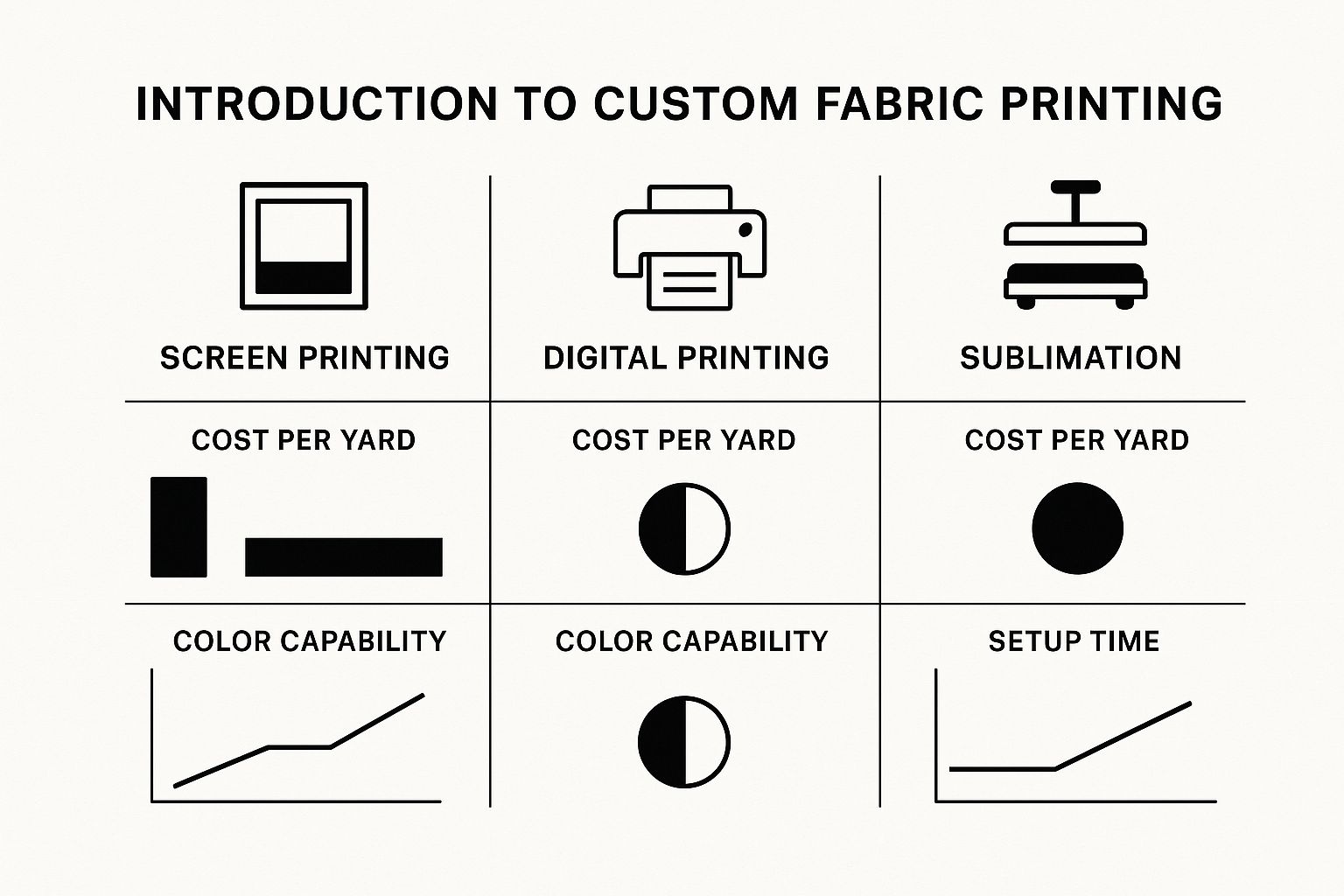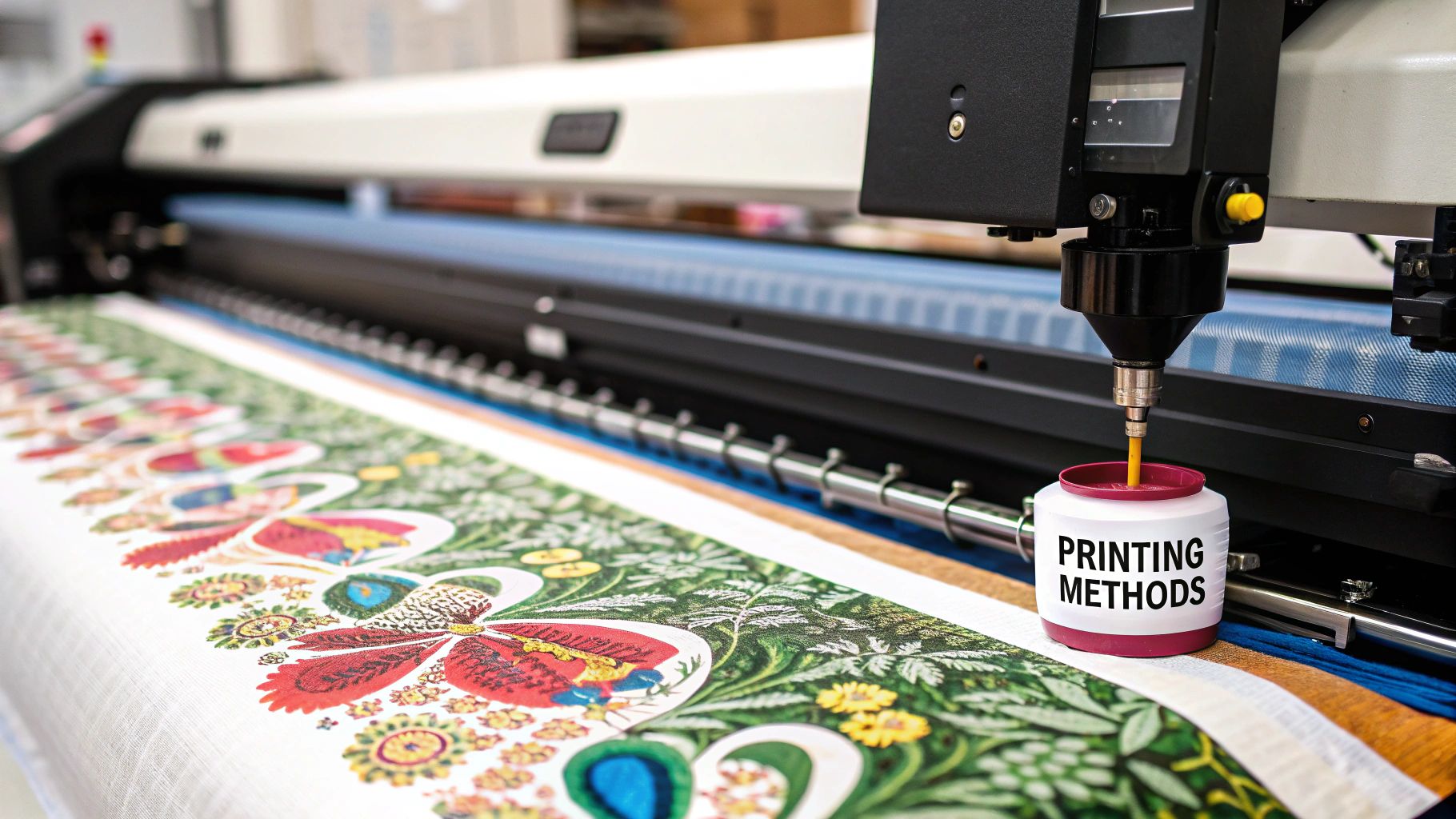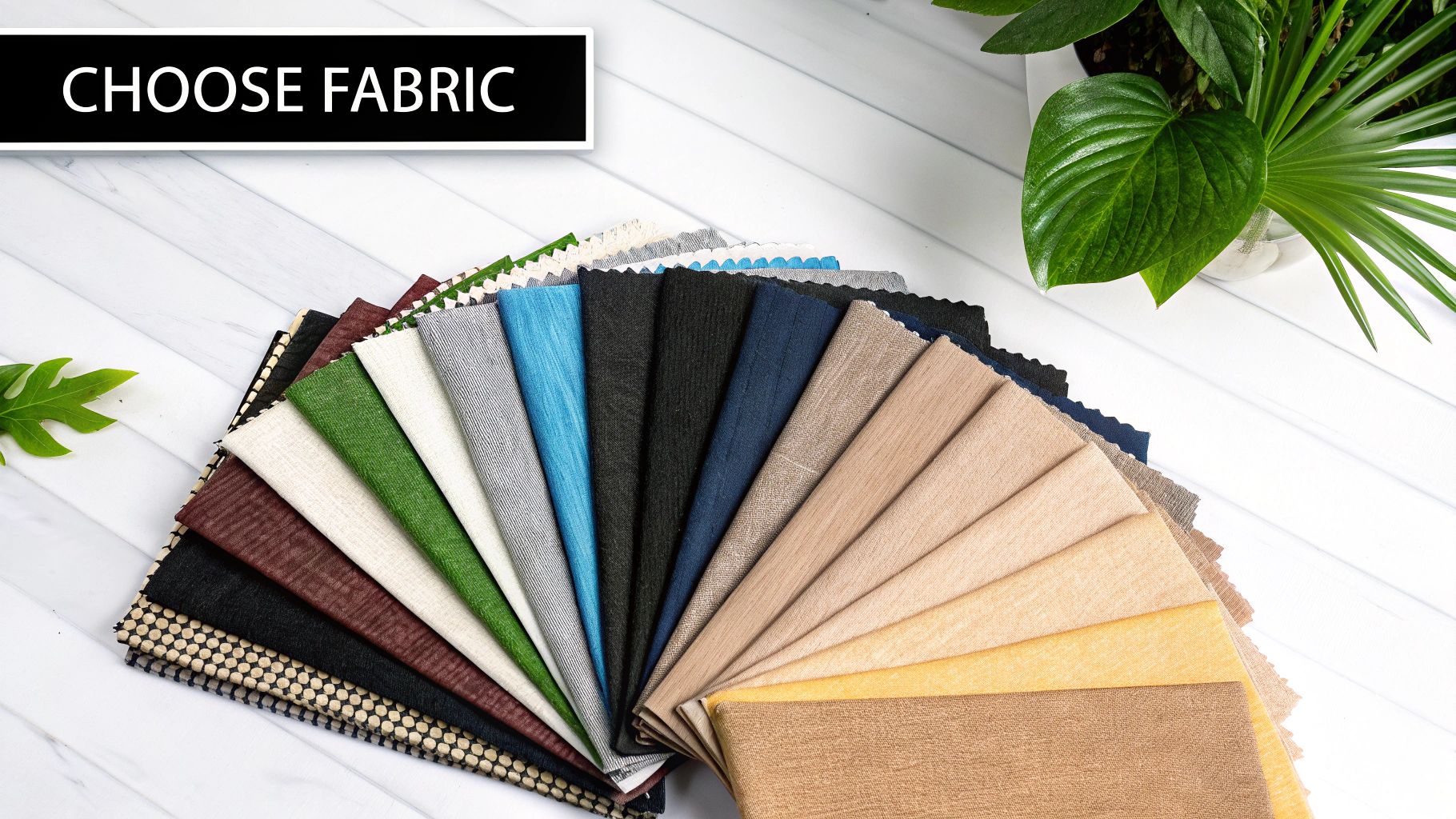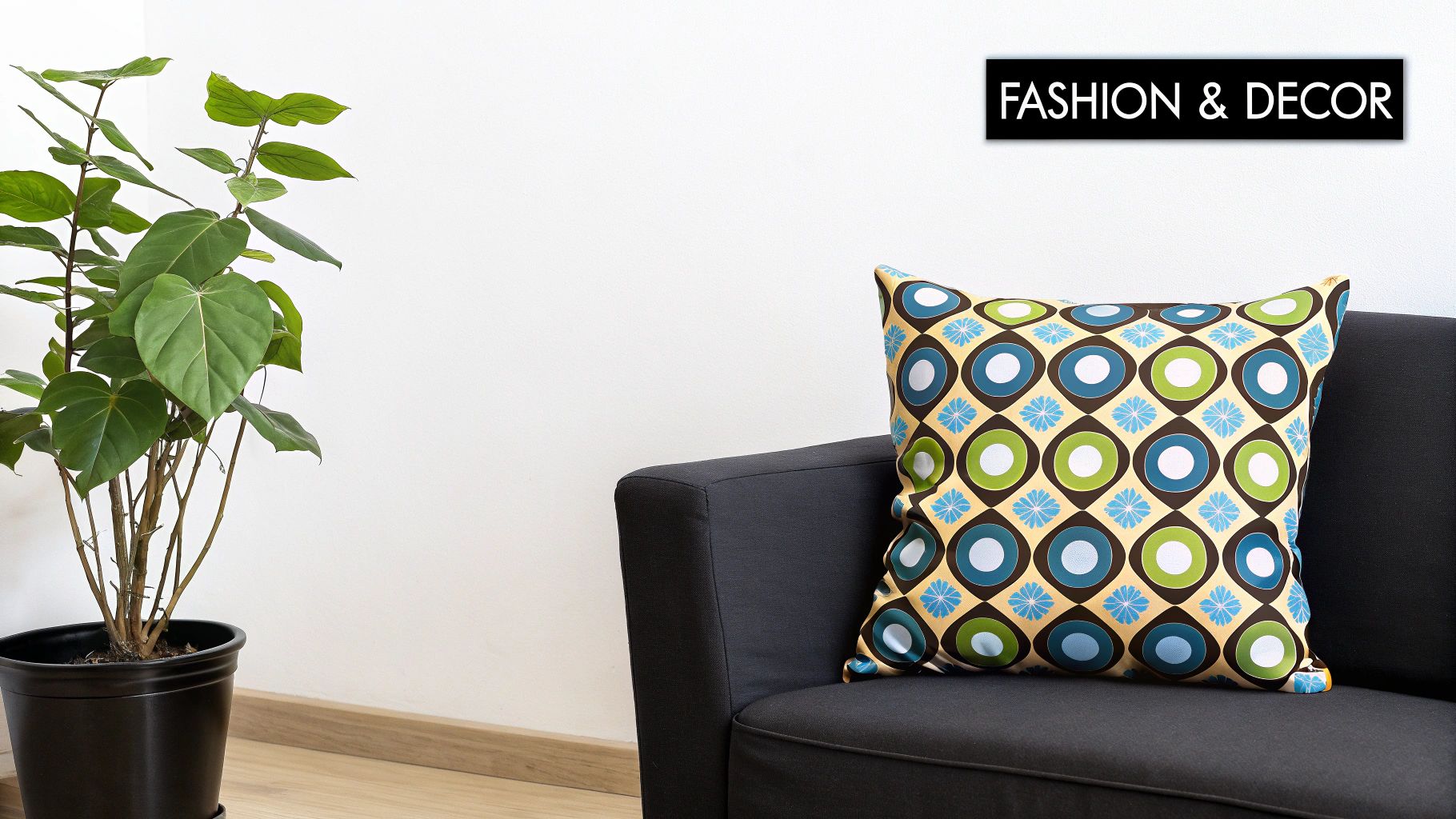Expert Custom Fabric Printing Techniques | Create Unique Textiles

The Evolution of Custom Fabric Printing in NZ

The infographic above provides a quick comparison of three popular custom fabric printing methods: screen printing, digital printing, and sublimation. It highlights key factors like cost, color capabilities, and setup time. Each method has its own set of pros and cons. For instance, digital printing excels in vibrant colors and fast setup, while screen printing offers cost savings for larger orders. Choosing the right method is crucial for achieving the perfect balance between budget and creative vision.
From Traditional Techniques to Modern Methods
Custom fabric printing in New Zealand has undergone a significant transformation. In the early days, traditional methods like screen printing were the industry standard. This involved a hands-on process of manually creating screens for each color.
While offering a tactile approach, these methods could be time-intensive and less versatile for intricate designs. This often resulted in shorter print runs and simpler patterns. Many local businesses utilized screen printing for branded merchandise or basic repeat patterns on fabrics.
However, the industry has evolved. The emergence of digital printing technologies has revolutionized textile personalization in New Zealand. Digital printing allows for intricate details, vibrant colors, and quicker turnaround times.
Furthermore, it enables on-demand printing, minimizing fabric waste and accommodating smaller, personalized orders. This has opened exciting new avenues for designers and businesses to craft bespoke fabrics. Imagine creating unique cushion covers with detailed Māori designs or personalized apparel with photorealistic prints – all now readily accessible due to advancements in digital textile printing.
Let's take a closer look at how fabric printing has evolved in New Zealand:
To better illustrate this evolution, the following table compares traditional and modern approaches to fabric printing in the New Zealand market:
Evolution of Fabric Printing in New Zealand
| Printing Method | Technology Used | Turnaround Time | Cost Range | Customization Level |
|---|---|---|---|---|
| Screen Printing | Manual screen creation | Longer (dependent on number of colors) | Lower for high volumes, higher for small runs | Limited by screen setup |
| Digital Printing | Inkjet or laser printers | Faster | Moderate, cost-effective for small runs | High, intricate designs possible |
| Sublimation Printing | Heat transfer process | Moderate | Moderate | High, vibrant colors, all-over prints |
This table highlights the key differences and similarities between these printing methods. Digital and sublimation printing offers greater customization and faster turnaround times, making them ideal for the increasing demand for personalized products. Screen printing, while still relevant for large volume orders, is facing competition from newer, more adaptable methods.
Navigating the Changing Tides of the Printing Industry
This progress has not been without its difficulties. The printing industry in Aotearoa, including custom fabric printing, has faced notable changes in recent years. The overall NZ printing industry has witnessed a decline in market size due to the growing preference for digital alternatives.
Industry revenue fell from approximately $1.4 billion in 2023 to $1.3 billion in 2024, representing a 7.5% decrease in a single year. The compound annual growth rate (CAGR) between 2019 and 2024 was -6.3%, and even sharper from 2018 to 2023 at -8.3%. For more detailed statistics, visit: IBISWorld.
This digital shift has prompted businesses to adapt and innovate to remain competitive. This involves finding ways to provide specialized, high-value services like custom fabric printing. Many NZ businesses have embraced this transformation, providing diverse printing options, from traditional hand-printed textiles to state-of-the-art digital prints. This reflects a broader movement towards personalization and unique product offerings.
The Future of Fabric Printing in NZ
The future of custom fabric printing in New Zealand appears promising. The increasing demand for personalized products and sustainable practices is creating opportunities for businesses to offer eco-friendly printing solutions and bespoke designs. This emphasis on sustainability aligns with New Zealand’s values and fuels innovation within the industry.
Consider the possibilities of printing on organic cotton with water-based inks, minimizing environmental impact while producing beautiful textiles. This is the future of custom fabric printing.
Digital vs. Traditional: Finding Your Perfect Printing Match

Choosing the right custom fabric printing method is a crucial first step for any project. This decision depends on understanding the core differences between digital and traditional techniques, especially in New Zealand. Each approach has its own pros and cons that can greatly affect your final product. This section explores those differences to help you find the perfect printing match for your needs.
Screen Printing: The Tactile Touch
Traditional methods, like screen printing, have long been a staple in textiles. Screen printing creates a tangible, textured finish. Think of it as stenciling: ink is pushed through a mesh screen onto the fabric, building a bold, layered effect.
This method is great for projects needing a handcrafted feel, especially those with simpler designs and larger quantities. Imagine a local sports club ordering a bulk batch of team jerseys – they'd likely benefit from screen printing's cost-effectiveness.
Digital Printing: The Realm of Detail
Digital printing offers a different set of advantages. This computer-driven process uses inkjet technology to apply ink directly to the fabric. Picture printing a high-resolution photo – digital fabric printing achieves a similar level of detail and vibrancy.
This precision makes it perfect for intricate designs, photographic prints, and projects needing a wide range of colors. Plus, digital printing excels with smaller print runs and personalized items, catering to the growing demand for bespoke textiles in New Zealand. This flexibility makes it popular for independent designers and artists creating limited-edition pieces.
Making the Choice: Factors to Consider
Several factors influence the choice between digital and traditional printing. Production volume is key. Screen printing’s setup costs make it more economical for large orders, while digital printing is better for smaller batches and one-offs.
Color complexity also matters. Digital printing shines when intricate color gradients and photorealistic images are essential. Screen printing, however, is great for bolder, simpler color palettes. Learn more in our article about How to master custom fabric printing.
Fabric type is another crucial factor. While screen printing works well with various fabrics, digital printing might be better for delicate materials or those needing a softer hand. Linen’s unique texture, for example, might be better suited to digital printing for a gentler finish. A robust canvas tote bag, on the other hand, could benefit from the durability of screen printing.
Finally, sustainability is increasingly important in New Zealand. Digital printing often uses less water and ink, reducing environmental impact. However, some screen printing studios are adopting eco-friendly inks and practices. This makes checking a printer’s sustainability efforts crucial, no matter your chosen method.
The broader Oceania region, including New Zealand, is seeing growth in the digital textile printing market. This sector is expected to expand steadily from 2023 to 2033, driven by innovations that allow for more sustainable and customizable fabric creation. Discover more insights about digital textile printing growth. This shift suggests that custom fabric printing in New Zealand is adapting to the demand for personalized, on-demand, and eco-conscious textile options.
Selecting Fabrics That Make Your Designs Shine
Understanding Fabric and Ink Interaction
Each fabric reacts uniquely to inks. Natural fibers like cotton readily absorb ink, resulting in a softer, more vintage aesthetic. This absorbency can, however, lead to slightly less vibrant colors compared to synthetic options. New Zealand's humidity can also affect drying times and color fastness on cotton.
Polyester, conversely, repels ink. This means the ink sits on the surface, producing brighter, more saturated colors. The trade-off can be potential cracking or fading with wear and tear, particularly with frequent washing or exposure to New Zealand's strong sunlight.
A fabric's weave also influences the final print. Tightly woven fabrics like linen provide a smooth printing surface for sharp details. Loosely woven fabrics, such as some cotton types, can yield a more textured, distressed look.
Fabric Selection for Different Projects
The intended use of your project dictates the ideal fabric choice. A durable outdoor cushion requires different properties than a delicate silk scarf. For outdoor use in New Zealand, weather-resistant materials like canvas or solution-dyed acrylic are excellent choices. These fabrics can withstand the elements and retain their vibrancy even under the intense Kiwi sun.
For clothing, natural fibers like organic cotton or merino wool offer breathability and comfort. Consider blending these with a small percentage of elastane for added stretch and durability.
When it comes to interior décor, fabrics like linen or silk introduce elegance, but demand more delicate care. For further guidance on material selection, explore this resource: How to master custom fabric printing.
Fabric Comparison for Custom Printing
The following table provides a detailed comparison of different fabric types and their suitability for various custom printing applications.
Fabric Comparison for Custom Printing
| Fabric Type | Print Quality | Durability | Best Applications | Environmental Impact | Cost Factor |
|---|---|---|---|---|---|
| Cotton | Soft, absorbs ink | Moderate | Apparel, home décor | Varies depending on farming practices | Moderate |
| Polyester | Vibrant, ink sits on top | High | Activewear, outdoor items | Synthetic, consider recycled options | Low to Moderate |
| Linen | Crisp, detailed prints | Moderate | Home décor, apparel | Generally sustainable | Moderate to High |
| Silk | Luxurious, smooth prints | Delicate | Scarves, high-end apparel | Moderate impact | High |
| Canvas | Durable, textured prints | High | Bags, outdoor furniture | Varies, consider organic options | Moderate |
As the table illustrates, each fabric offers a unique combination of print quality, durability, and cost. Choosing the right fabric involves carefully balancing these factors against your project’s specific needs.
Sourcing Fabrics in New Zealand
Sourcing fabrics locally within New Zealand supports local businesses and minimizes your environmental footprint. Many New Zealand suppliers specialize in eco-conscious materials like organic cotton and hemp. These suppliers often prioritize sustainable farming and production, aligning with New Zealand's commitment to environmental responsibility.
Local sourcing also simplifies communication and reduces delivery times, which can significantly streamline your production process. This is particularly advantageous for small businesses and independent designers. Building relationships with local fabric suppliers can also provide valuable industry knowledge and access to exclusive materials.
Choosing the right fabric for custom printing is paramount to achieving the desired result. By carefully considering fabric properties, project requirements, and sourcing options, you can create beautiful, long-lasting textiles that truly reflect your vision. Understanding these key elements can help you avoid costly errors and elevate your custom fabric printing projects.
Designing For Fabric: Beyond Paper and Screen

Creating designs for custom fabric printing presents a unique set of considerations compared to designing for paper or screen. The texture and drape of the fabric itself introduce both challenges and exciting possibilities. Understanding how your design will appear on a three-dimensional, flexible surface is key to achieving a successful outcome. This section explores the necessary adaptations for vibrant and effective fabric printing.
Understanding Pattern Flow and Scale
When designing for fabric, it's essential to consider how the pattern will flow across the material. A design that appears balanced on a flat computer screen might look distorted or disjointed when printed on a curved surface like a cushion or draped across a curtain. Think about the final form your fabric will take.
Scale also plays a crucial role. A small, intricate pattern might get lost on a large piece of fabric, such as a duvet cover. Conversely, a large, bold print could overwhelm a smaller item. Always keep the intended use of your fabric in mind when deciding on the scale of your design.
Managing Color Expectations: Screen vs. Fabric
Colors often appear different on fabric compared to a computer screen. Screens use illuminated light, while fabric colors are perceived through reflected light. This difference can lead to unexpected results, particularly with bright or highly saturated colors. The fabric type itself also impacts color absorption and vibrancy.
Using a color chart specific to your printing method and chosen fabric is highly recommended. This will give you a much more accurate preview of the final printed colors. Many New Zealand print providers offer these charts to ensure accurate color matching for your projects.
Adapting Existing Artwork for Textiles
Adapting existing artwork for fabric printing requires careful attention to detail. The resolution of your artwork is paramount; it needs to be high enough to maintain clarity and detail on the fabric. Low-resolution images will appear pixelated or blurry when printed. You should also pay attention to the color profile. Converting your artwork to the appropriate color profile for fabric printing is vital for color accuracy.
Professional Workflows for Fabric Printing
Adopting professional workflows can streamline the design-to-print process. Using vector-based software like Adobe Illustrator is recommended for creating your designs. Vector graphics are scalable without losing quality, which is crucial for ensuring your designs remain sharp and clear, no matter the size.
Proper file preparation is also essential. Saving your files in the correct format and size, as specified by your print provider, ensures a smooth printing process and minimizes potential issues. Many New Zealand print providers prefer file formats like PDF or TIFF to preserve image quality. Clear communication with your print provider regarding their preferred file specifications is key to a successful result and helps avoid delays. This will ensure your final product matches your original vision.
By understanding these design principles specific to fabric printing, you can create textiles that are both aesthetically pleasing and functional. This knowledge empowers you to confidently bring your custom fabric printing projects to life in Aotearoa.
Navigating NZ's Custom Fabric Printing Landscape
Finding the right printing partner is essential for a successful custom fabric project. This section explores New Zealand's textile printing industry and what sets excellent providers apart. We'll cover evaluating potential partners, understanding pricing, managing project timelines, and building productive relationships.
Evaluating Potential Print Providers
Choosing a custom fabric printing partner requires careful consideration. Begin by assessing their equipment capabilities. Do they offer the printing method you need, such as screen printing, digital printing, or sublimation? A provider specializing in large-scale screen printing might not be suitable for a small batch of digitally printed silk scarves.
Next, consider their material knowledge. A good provider understands how different fabrics interact with various inks and printing processes, especially within New Zealand's climate. Can they advise on the best fabric for your project, considering durability and color fastness in local conditions?
Customer service is also key. Look for responsive and communicative providers willing to guide you. A collaborative approach, particularly for complex projects, can significantly impact the final result.
Understanding Pricing and Timeframes
Pricing for custom fabric printing varies based on the printing method, fabric type, order size, and design complexity. Screen printing is generally more cost-effective for large orders, while digital printing suits smaller runs.
Obtain detailed quotes from multiple providers to compare pricing and ensure transparency. In the first quarter of 2021, New Zealand's printing manufacturing sector recorded sales worth approximately NZD 316 million. This illustrates the industry's scale and the growing importance of custom printing. Find more detailed statistics here.
Project timelines are crucial. Realistic timeframes depend on the provider's capacity, project complexity, and the chosen printing method. Discuss deadlines upfront and ensure the provider can meet your requirements without compromising quality.
Effective Communication Strategies
Clear communication is fundamental. Establish a clear communication channel with your chosen provider. Regular updates, prompt responses, and open discussions about potential challenges are essential for keeping your project on track. When designing for fabric, consider the visual impact, as discussed in this article about the power of Images in Web Design.
Building Productive Relationships
Building strong relationships with print providers offers long-term benefits. This can lead to preferential pricing, quicker turnaround times, and a more collaborative approach for future projects. Treat your print provider as a partner, valuing their expertise and respecting their processes. You might be interested in: How to master custom fabric printing. By understanding these elements, you'll be better equipped to navigate New Zealand's custom fabric printing landscape and bring your textile visions to life.
Sustainable Fabric Printing: Beyond Eco-Friendly Claims

In New Zealand, we're passionate about protecting our environment. This eco-conscious mindset influences our decisions, even down to custom fabric printing. But how can we tell the difference between genuine sustainable practices and clever marketing? This section helps you navigate eco-friendly claims and make informed choices.
Deconstructing Eco-Friendly Buzzwords
Terms like "eco-friendly" and "sustainable" are often used casually. True sustainable fabric printing, however, involves a much deeper commitment. It's about a holistic approach that considers every stage of production.
This includes the inks, the printing method, and waste management. For example, some companies might claim to be eco-friendly simply because they use water-based inks.
While water-based inks are generally preferable to solvent-based inks, this alone doesn't guarantee true sustainability. Factors like the water source, energy used during printing, and wastewater disposal all contribute to the overall environmental impact.
Evaluating Environmental Claims with Accuracy
To truly assess a company's sustainability, look beyond general claims. Ask specific questions. What are their water conservation efforts? Do they minimize water usage and treat wastewater responsibly?
What about their energy efficiency? Are they using renewable energy or strategies to reduce energy consumption during printing? Also, examine their material selection. Do they prioritize sustainable fabrics like organic cotton or recycled polyester? A truly sustainable print studio will be transparent and provide details about its environmental impact. Don't hesitate to ask for evidence to support their claims. You might also be interested in how to master custom fabric printing.
Balancing Sustainability and Project Requirements
Sometimes, balancing sustainability with project needs can be tricky. Certain projects might require materials or processes that aren't perfectly aligned with ideal environmental practices. For instance, achieving a particular color vibrancy might necessitate a specific type of ink.
Even with these constraints, you can still prioritize sustainability. Explore alternative fabric options or discuss compromises with your print provider. Perhaps a slightly less vibrant color can be achieved with a more sustainable ink.
Leading Print Studios in NZ: A Look at Best Practices
Many leading print studios in New Zealand are embracing genuinely sustainable practices. They're investing in water recycling systems and using energy-efficient equipment. They are also prioritizing locally sourced materials and implementing closed-loop systems where waste is minimized and byproducts are reused or recycled.
These practices not only reduce their environmental footprint but also lead to cost savings and improved efficiency. For businesses looking to integrate custom fabric prints with an online store, consider Custom Shopify Development. By supporting businesses committed to authentic sustainability, you are contributing to a greener future for Aotearoa. This demonstrates a commitment to responsible textile printing and positions these studios as leaders in the New Zealand market. By making informed choices, you ensure your projects align with your environmental values.
Bringing Custom Fabric Printing Projects to Life
Transforming inspiration into a physical product takes careful planning. This section offers practical advice for bringing your custom fabric printing projects to life, from initial idea to the finished item. We'll also explore how successful local designers in New Zealand manage their production process.
From Concept to Creation: A Step-by-Step Guide
The journey from design idea to finished fabric product involves several key phases:
-
Concept Development: Define your project goals. What are you making? Who is your target customer? What's your budget? A strong concept is the foundation of any successful project.
-
Design Creation: Turn your concept into a visual design. Think about the fabric type, printing method, and the look you're going for. This is where your creative vision truly takes form.
-
Sample Creation: Before starting full production, create a sample. This helps you see the design on your chosen fabric and make changes to color, scale, or pattern.
-
Production: Once you're happy with the sample, you can begin full-scale production. Work closely with your printing partner for a smooth process.
-
Finishing Touches: Post-printing steps, such as heat setting or applying protective coatings, can improve the durability of your printed fabric, especially in New Zealand's varied climate.
Calculating Material Requirements and Managing Print Variations
Calculating your material needs accurately is vital to avoid costly overruns or shortages. Consider seam allowances, pattern repeats, and potential print variations. Small variations in color or pattern can happen during printing, especially with large designs.
Talk to your printing partner about acceptable tolerances and ask for a strike-off, a test print on your chosen fabric. This allows you to approve the final look before production starts.
Building Realistic Project Timelines
Setting realistic timelines is essential for project success. Include design time, sample creation, production lead times, and any finishing processes. Discuss timelines with your printer early on to ensure they can meet your deadlines.
Post-Printing Considerations: Finishing, Care, and Quality Control
Proper fabric finishing is key for a professional product and a longer lifespan for your textiles. Think about using a heat set to fix the ink and prevent fading, especially for items that will be washed regularly.
Giving clear care instructions to your customers helps them maintain the quality of the printed fabric. This is important in New Zealand, where sunlight and humidity can affect fabric durability.
Using quality control throughout production helps find and fix any defects early. This might include inspecting the fabric before printing, watching the printing process, and doing a final check before delivery.
Real-World Examples: Bringing Custom Fabric Printing to Life in Aotearoa
Imagine a local designer creating cushion covers featuring native New Zealand flora. They select a durable, eco-friendly linen and work with a local printer using water-based inks. They provide detailed care instructions, advising on how to maintain the vibrancy of the print in New Zealand's climate.
Another example is a business creating custom-branded tote bags for a local market. They choose a sturdy canvas and use screen printing for a cost-effective, bold design. They work closely with their printer to ensure the final product matches their branding and quality standards.
These examples show how planning and execution, along with an understanding of the printing process, lead to successful projects. By following these tips, you can turn your creative ideas into beautiful textile products.
Ready to make your printing dreams a reality? Explore the options with Maak Home, a New Zealand studio specializing in custom cushions, fabrics, curtains, and wallpapers. Transform your home or business with unique, eco-conscious textiles made in Aotearoa.









